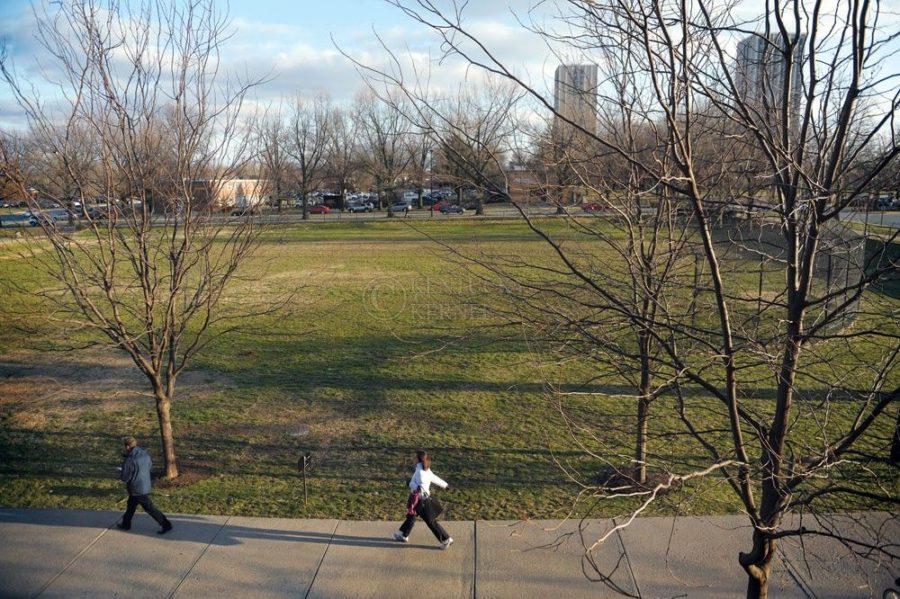New dorm could replace Haggin Field
January 19, 2012
Some UK students have recently voiced concerns over a new proposal that would eliminate a popular sports field located in front of the Haggin Hall dormitory and replace that green space with an Honors Academy.
On Oct. 25, President Eli Capilouto detailed the plan for a $30 million, multi-year campus building and renewal project, one aspect of which would include the construction of the honors residence.
“I don’t like it because it’s one of the only places where I actually see people gathering and playing,” Paul Dengel, a sustainable agriculture junior, said. “If the space isn’t next to the dorm, then people aren’t going to go get exercise…it’s the path of least resistance.”
Another junior studying sustainable agriculture, Mims Russell, said he thinks green spaces are an integral part of college life, acting as recreation areas while helping to relieve stress. He said he is concerned about the loss of Haggin Field.
“I see that field being used a lot, and the space next to a dorm is so inviting, encouraging people to get out and get active,” Russell said. “The less space available to the students, the less it’s encouraged.”
Some students have a positive outlook on the construction, believing that the repurposing of the field is for a great cause.
“If it’s between having a space to play games and having an Honors Academy, I lean more towards having an Honors dorm,” John Matthews, a junior mechanical engineering major, said.
Research has shown that green spaces have an impact on a person’s mental and physical being.
Studies done by the Vrije Universiteit University Medical Center in Amsterdam and published in the Journal of Epidemiology and Community Health experimented with this very question, and discovered that people living closer to green spaces have lower rates of anxiety, depression and poor physical health compared to those who live in the concrete jungle.
In addition, the same study found that 15 of 24 major diseases were less prevalent among individuals living near green spaces.
A July 2010 New York Times article detailed the findings of a study into a common social practice of Japan called “Shinrin-yoku” or “forest bathing,” which concluded that subjects who spent time in the forest experienced a 50 percent boost in their levels of natural “killer” cells that are essential components of the immune system that battle tumors and viruses.
UK officials said they are aware of the short and long-term benefits of green spaces on campus, and are working to increase landscaping and recreational areas, as well as develop more opened spaces and sculpture.
“I have always believed that it’s our green spaces and landscaping that defines our campus, and not our architectural abilities,” Bob Wiseman, vice president for Facilities Management, said.
Wiseman said a master plan was drawn up in 2002 by the architecture firm Ayers Saint Gross, laying out the design for UK’s campus through the year 2050.
As to why the Haggin Field site was chosen specifically for the Honors Academy, Wiseman and others said it was because of the significant advantages the location offered for that design.
“(Ayers Saint Gross) did a capability analysis and determined that (Haggin Field) was the best location for the building that did not require demolition,” Warren Denny, UK architect, said.
The assumption for administrators is that as time goes on UK will become a more urban environment. But the university wants to continue to create similar green spaces throughout campus to give the school a look of continuity with straight linked green spaces.
“Students are just as concerned as we are about green spaces on campus…we share this common issue,” Wiseman said. “We will continually change and improve to protect our green image, but the students of 2030 will continue to recognize green spaces but not the campus as it is now.”
Still others don’t believe that the university is doing enough to encourage an environmental agenda on campus.
“We should be planting native, indigenous plants, that can be of benefit in teaching,” David Atwood, a Chemistry Department professor, said, “using no pesticides or herbicides, encouraging birds and insects to create habitats in this ecosystem, and reduce our carbon footprint by planting more trees.”
Atwood would like to see more direct student involvement in the agriculture and landscaping of campus, and thinks that students would gain from seeing a symbiotic relationship between nature and the laboratory.
UK is currently wasting a valuable opportunity to teach, Atwood said.
“We have decorated this campus the same way that substandard housing is decorated — with the same plants even,” Atwood said.
Atwood has petitioned the university to create an Environmentalism and Sustainability Bachelor of Arts degree which would be dedicated to this method of learning, possibly allowing students the opportunity to take more direct hand in the environmental aspects of the school.
For now, students who are interested in green spaces on campus are encouraged to get involved in environmental programs already offered on campus.
Students have been working together to make UK a member of Tree Campus USA, and plant more trees throughout campus, Shane Tedder, UK sustainability coordinator, said.
This effort has been well received by the administration, and the issue is being examined for approval, Tedder said.
“There are plenty of volunteering opportunities available at the Arboretum, our sustainability awareness program called Great Outdoors, and students can also check out our community gardens,” he said.
For more information about these programs, visit:
http://www.arborday.org/programs/treecampususa/
http://www.sustainability.uky.edu/node/37
http://www.ca.uky.edu/arboretum/Joinus.php, http://getinvolved.uky.edu/cco/Page.aspx?PageId=3#greatoutdoors
































































































































































